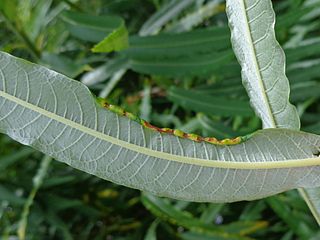
Rabdophaga rosaria is a gall midge which forms Camellia galls or terminal rosette gall on willow species. It was first described by Hermann Loew in 1850.

Rabdophaga is genus of flies in the family of gall midges Cecidomyiidae. There are 105 species distributed through Africa, Asia, Europe and North America. Most species of Rabdophaga gall willows ; one exception is R. giraudiana which galls the stems of poplars.
Rabdophaga repenticornua is a gall midge which forms galls on the buds of creeping willow.
Rabdophaga strobilina is a gall midge which forms galls on the buds of some species of willow. It was first described by Hermann Loew in 1850.
Rabdophaga iteobia is a gall midge which forms galls on the buds of willow species.
Rabdophaga heterobia is a species of gall midges which has two generations a year and forms galls on almond willow. It was first described by Hermann Loew in 1850.
Rabdophaga jaapi is a species of gall midges which forms galls on creeping willow.

Rabdophaga rosariella is a species of gall midge which forms galls on sallows. It was first described by Jean-Jacques Kieffer in 1897.
Rabdophaga saliciperda is a species of gall midges which forms galls on willows. It was first described by Léon Jean Marie Dufour in 1841.

Rabdophaga salicis is a gall midge which forms galls on sallows. It was first described by Franz von Paula Schrank in 1803.
Rabdophaga degeerii is a gall midge which forms galls on the shoots of willows.
Rabdophaga albipennis is a gall midge which forms galls on the shoots of white willow.
Rabdophaga karschi is a gall midge which forms galls on the twigs of sallows.
Rabdophaga dubiosa is a gall midge which forms galls on the young shoots of willow.
Rabdophaga purpureaperda is a gall midge. The larvae tunnel in the shoots of purple willow and may cause the shoots to swell slightly. It was first described by Horace Francis Barnes in 1935.

Rabdophaga marginemtorquens is a gall midge which forms galls on willows and is found in Europe. It was described by Johann Jacob Bremi-Wolf in 1847.
Rabdophaga roskami is a gall midge which may form galls on common ossier or, the larva live in the galls formed by R. marginemtorquens. It was first described by H Stelter in 1989.
Rabdophaga clausilia is a gall midge which, depending on the source, forms galls on the leaves of willows, or is an inquiline living in the galls of a Rabdophaga species, or a predator. It was first described by Johann Jacob Bremi-Wolf in 1847.

Rabdophaga nervorum is a gall midge which forms galls on the leaves of sallows. It is found in Europe and was first described by the French entomologist, Jean-Jacques Kieffer in 1895.

Rabdophaga salicisbrassicoides, known generally as the willow rosette gall midge or willow cabbage gall midge, is a species of gall midges in the family Cecidomyiidae. Their galls and larvae thrive in association with the mutualistic relationship between Formica neoclara and Chaitophorus aphids found on their host species Salix exigua. The larva overwinter in their galls, and adults emerge in late April.







